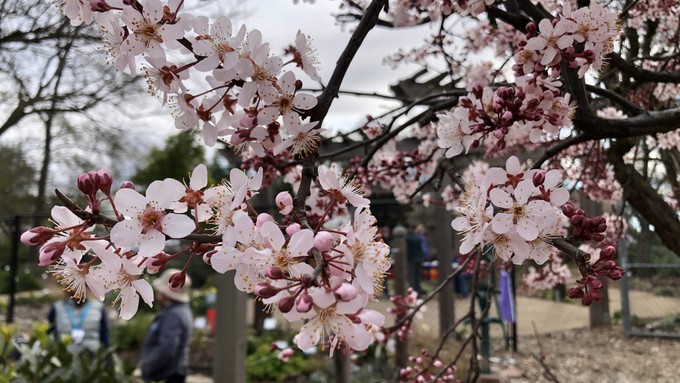
Flavor of oranges may actually get a boost from 'kiss of cold'

Our warmer afternoons have prompted some fruit trees to push out blossoms already, such as on this multi-grafted fruit salad tree, photographed Feb. 11 at the Fair Oaks Horticulture Center. But freezing temperatures could threaten any eventual crop. Kathy Morrison
Our afternoons may feel like spring, but frost danger is still in our forecast. And that creates some challenges for Sacramento-area gardeners: All that tender new growth may need protection.
The National Weather Service warns of “widespread frost” on Thursday and Saturday morning in the greater Sacramento area and foothills. Overnight lows are expected to dip into the low 30s if not below freezing.
Frost threatens not only new shoots but tender blossoms and buds. Sacramento reached 71 degrees on Sunday, Feb. 12. Such warm weather coaxed out early blooms on some fruit trees. Frost can cause those blossoms to fall quickly without setting fruit.
Likewise, frost can burn newly rooted cuttings or transplanted seedlings – even if the temperature stays above 32 degrees. Protect these babies with row covers or “hot caps” – mini-greenhouses made of waxed paper or improvised with plastic milk jugs (with the bottom cut out).
A clear night with no wind can actually produce more frost damage than a windy night at the same temperature. According to university research, foliage temperatures on citrus trees were three to four degrees lower than surrounding air temperature on clear, windless nights. So, 34 degrees could actually feel like 30 to a tender lime or lemon. Young trees are most susceptible to cold damage.
Most citrus is OK down to 30 degrees. Some “chill hours” – time spent under 45 degrees but above freezing – may actually improve the flavor and quality of ripening oranges. That “kiss of cold” brings out the sugars while toughening the skin, extending the fruit’s longevity on and off the tree.
One of the easiest ways to protect sensitive plants: Water. Irrigate your garden before a frost warning; moist soil radiates heat and offers some frost insurance. (The exception are succulents; they soak up that extra moisture and can actually burst if their cells freeze.)
What if a tree or shrub has already suffered frost damage? Leave it on the plant for a few more weeks; it can protect the plant from further damage.
This frost warning is later than usual for Sacramento. After decades of recommending a “last frost” date of mid March, most experts now cut off our frost period at the end of January. According to the Sacramento County master gardeners, our average last frost date is Jan. 27.
But in 2022, Sacramento hit 32 degrees on Feb. 24 and dipped down to 35 degrees on March 6. Our latest ever freeze on record (30 degrees) hit March 27, 1898.
Surrounding communities need to watch out for frost and freeze much later than Sacramento with some areas under threat well into spring. The master gardeners list last frost dates for Marysville (March 16), Lodi (March 31), Woodland (April 1), Auburn (April 13), Davis (April 18), Placerville (May 18) and Nevada City (June 4).
For more tips on frost protection: https://sacmg.ucanr.edu/Frost_Protection/.
Comments
0 comments have been posted.Sacramento Digs Gardening to your inbox.
Food in My Back Yard Series
May 6: Maintain soil moisture with mulch for garden success
April 29: What's (already) wrong with my tomato plants?
April 22: Should you stock up on fertilizer? (Yes!)
April 15: Grow culinary herbs in containers
April 8: When to plant summer vegetables
April 1: Don't be fooled by these garden myths
March 25: Fertilizer tips: How to 'feed' your vegetables for healthy growth
March 18: Time to give vegetable seedlings some more space
March 11: Ways to win the fight against weeds
March 4: Potatoes from the garden
Feb. 25: Plant a fruit tree now -- for later
Feb. 18: How to squeeze more food into less space
Feb. 11: When to plant? Consider staggering your transplants
Feb. 4: Starting in seed starting
Sites We Like
Garden Checklist for week of May 4
Enjoy this spring weather – and get gardening!
* Plant, plant, plant! It’s prime planting season in the Sacramento area. Time to set out those tomato transplants along with peppers and eggplants. Pinch off any flowers on new transplants to make them concentrate on establishing roots instead of setting premature fruit.
* Direct-seed melons, cucumbers, summer squash, corn, radishes, pumpkins and annual herbs such as basil.
* Harvest cabbage, lettuce, peas and green onions.
* In the flower garden, direct-seed sunflowers, cosmos, salvia, zinnias, marigolds, celosia and asters. (You also can transplant seedlings for many of the same flowers.)
* Plant dahlia tubers. Other perennials to set out include verbena, coreopsis, coneflower and astilbe.
* Transplant petunias, marigolds and perennial flowers such as astilbe, columbine, coneflowers, coreopsis, dahlias, rudbeckia and verbena.
* Keep an eye out for slugs, snails, earwigs and aphids that want to dine on tender new growth.
* Feed summer bloomers with a balanced fertilizer.
* For continued bloom, cut off spent flowers on roses as well as other flowering plants.
* Add mulch to the garden to maintain moisture. Mulch also cuts down on weeds. But don’t let it mound around the stems or trunks of trees or shrubs. Leave about a 6-inch to 1-foot circle to avoid crown rot or other problems.